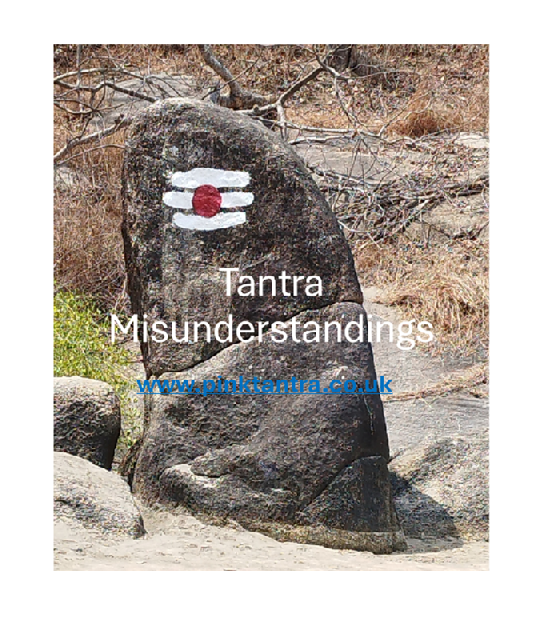Tantra Misunderstandings
I’ve been reading Tantras: Their Philosophy and Occult Secrets, edited by Dhirendra Nath Bose, and three key misunderstandings jump out for me; (1) the relative newness of Tantra, (2) the anthropomorphic nature of the Divine, (3) and the masculine/feminine principle.
 Let’s look at these one-by-one.
Let’s look at these one-by-one.
1. The relative newness of Tantra.
I often hear people say Tantra originated somewhere around the 11th Century AD with the writings of Abhinavagupta. In fact some people seem to think it was around the 1960's or 1970's with the advent of Neo-Tantra. However as Bose makes clear, the Tantras, also known as the Agamas, existed from the time of the Vedas (anywhere between 1,500-500 BC), and indeed are “simple allegorical expositions of the philosophy and theology of the Vedas.” Further, “even judging from the point of antiquity, is not of recent origin, but it is as old as any other form of Vedic religion.”
Certainly Tantrikas were practicing and Tantra was highly in vogue, during the days of the Purans, between 3-10th Century AD. Abhinavagupta simply brought a cohesion to the array of Tantras and Agamas.
2. The anthropomorphic nature of the Divine.
I can’t begin to number the times I’ve heard arguments around which image of god is the ‘right’ portrayal, whether they are male or female, old or young, bearded or beardless, and on and on. The Divine, God/ess, Consciousness (or whatever word we prefer) is impersonal, attribute-less. Hence, there are no words adequate to describe it, and it is beyond the grasp of the human mind. However, as Bose notes, quoting Dr. Martineau’s elaborate work around philosophical theories about religion, an “Impersonal God cannot be worshipped.”
This led to the need to anthropomorphosise the Divine. The problem with this is that we are limited by our anthropomorphic idea and can quickly become stuck in believing our limited view. An anthropomorphic view of the Divine is simply a starting point not an end in itself.
3. The Masculine / Feminine Principle.
Tantra is renowned for explaining ‘creation’ as an analogy of sexual union. It’s an analogy! And a misleading one at that. The union actually refers to matter and force, or consciousness and energy. It is only through our anthropomorphism that this became known as Shiva and Shakti, masculine and feminine. The Hindu Shastras famously conveyed the union of Purusha and Prakriti as Ardhanariswara; the half-male, half-female god.
But as Bose says, “They are not two double-stars, two independent co-existent things conjoined together …” Shiva and Shakti are one and the same; two modes of the same thing, it is quite misleading to position them as opposing masculine and feminine principles. They are actually manifestations of the Eternal; matter and force, consciousness and energy, or even material and spiritual.
Bringing it all together
Bose says that “the Tantras make an extensive use of mystic symbols, which were and are very often misinterpreted either from ignorance or from corrupt motives.” He is evidently a bit more cynical, specifically when referring to the 5 M’s and especially Maithuna, further stating that Tantra was “corrupted by their vicious adherents, by men, which the Tantras have, themselves described to be of Pashu Bhava, ie, of animal proclivities.”
Here, especially in relation to Maithuna, which rather than the usual engagement in sexual union, he defines as meditation on the acts of creation and destruction. He notes, that as Tantric “worship is generally more absorbing than other forms, as it tries to turn even all instincts and appetites of man for the cultivation of religion and for such moral and spiritual culture that may stand the test of all worldly temptations”, it can have the opposite effect, bringing about a great sense of delusion.
Connect on Twitter / Instagram / Facebook
Message me direct if you are interested in yoga, therapeutic yoga, kundalini tantra yoga, tantra practices, trauma-informed coaching, spiritual coach, gay coach, mindfulness and behavioural coaching, Reiki or stress management robert.pinktantra@gmail.com
See my personal development / personality profiling book DISCover the Power of You published through John Hunt Publishing Ltd, 2017. ISBN: 978-1-78535-591-2
And for those who enjoy historical fiction, stories of underrepresented life’s, see my first novel Fermented Spirits published through Austin Macauley Publishers, 2022. ISBN-13: 978-1398437159